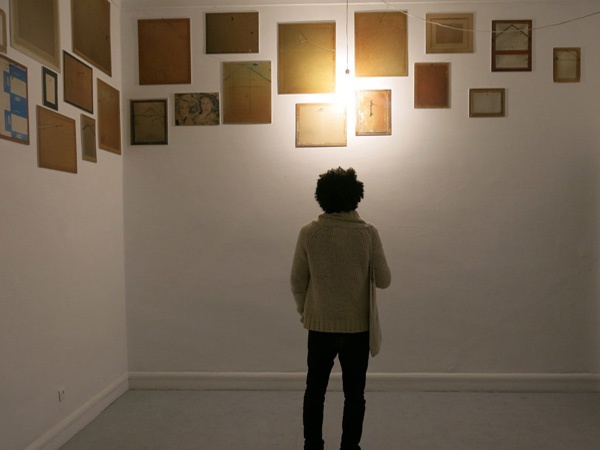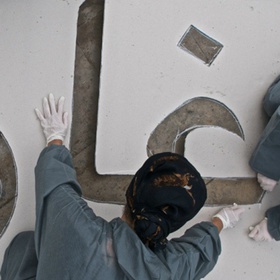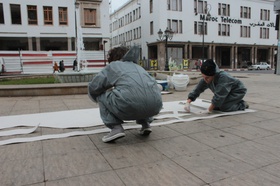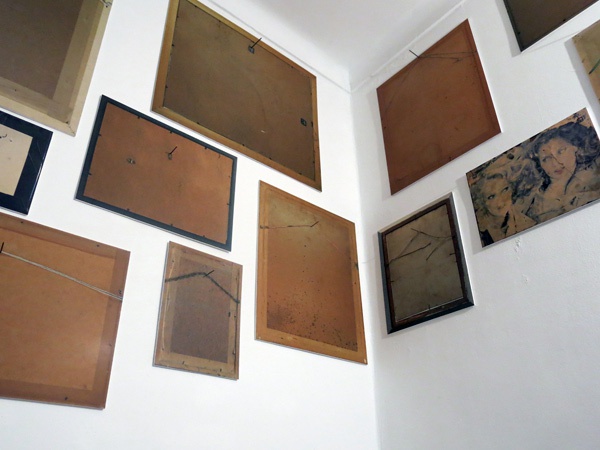Interviews
With Nail and Spring
Georgia Kotretsos in conversation with Stephanie Bailey
From January 2013 to December 2014, Georgia Kotretsos undertook a one-month run as artist-in-residence at L'appartement22, in Rabat, Morocco, an independent space for contemporary art that organizes exhibitions, workshops, and residency programs. During this time, she produced a photography-based exhibition titled KARFI (Greek for 'nail': Kαρφί), produced specifically for L'appartement22. Kotretsos also staged a public performance in front of the capital's parliament building on Mohamed V Avenue, entitled Spring Cleaning (2014), which was produced by Women With Talents (WWT), a collective Kotretsos formed along with Athens-based artist Natasha Papadopoulou. In this interview, Kotretsos discusses both projects.
Stephanie Bailey: How did you come to the residency at L'appartement22?
Georgia Kotretsos: I came to know of the space in 2006 while preparing a piece for Boot Print Vol.I/Issue II,[1] a publication I founded and edited in the USA between 2006 and 2010. The piece was about independent curators, titled 'Every Unemployed Curator is not an Independent Curator'.[2] Six curators were interviewed, one being Abdellah Karroum, the founder of L'appartement22. Two curators from Greece were also featured in the piece, Sotirios Bahtsetzis and Elpida Karaba; Cecilia Canziani from Italy; Jan van Woensel from Belgium, and Dana Turkovic from the States.
SB: What was the impetus behind conducting interviews with these figures?
GK: My choices for this article were not random. My intention was to genuinely try to get to know, and perhaps understand, the motivations and ambitions of my interviewees. Motivated by my own doubts and suspicions about the vast majority of fairly young independent curators I was meeting at the time, I wanted to understand who is who and what it is exactly that a curator does. In the 1990s, there was a curatorial boom where everyone went to study how to become a curator, and specifically an independent one. It was the decade of curatorial fever, where degrees and programs mushroomed everywhere. All six curators featured in the piece were part of that generation that had graduated from college, and they were either starting out, or were at an emerging stage of their career or were already mid-career curators.
But the selection process also had to do with geography. Boot Print was published out of St. Louis, Missouri, in the USA; I was living between the USA, Greece and partly South Africa, up to that point. My intention was always to keep Boot Print connected to St. Louis but I wanted it to be in conversation with the world beyond that. And then, when I would find myself in Athens for three months at a time working on Boot Print, I wanted to reflect the creative energy of the city and the wider region, meaning the Mediterranean. I always work with a map, and this is how I understood Greece's sense of belonging.
So, the profiles of the curators completed this mapping. For instance, Dana Turkovic, originally from St. Louis had just returned to her home town after completing an MA in curatorial studies at Goldsmiths College in London; Sotirios Bahtzetsis was living and working between London, Berlin and Athens; Elpida Karaba had just returned to Athens from London after attaining an MA from both City University and Goldsmiths College to be a PhD candidate at the University of Patras in Greece. Jan Van Woelsen although educated in Antwerp, Belgium, was living and working in New York; Cecilia Canziani had also recently returned to Rome from London where she attained an MA in curatorial studies from Goldsmiths College and who had founded I:I projects, operating between Rome and London; and finally Abdellah Karroum who was educated in Bordeaux at the Université Michel de Montaigne, and was in his fourth year of running his alternative space L'appartement22 in Rabat, Morocco. Some were also teaching at the time, some were affiliated with commercial galleries, others were doing independent research, pursued publishing, the list is very long – the areas of their practices were immensely broad.
SB: In the case of Abdellah Karroum, can you talk about how you have worked with him since this interview for Boot Print?
GK: As an artist, when I look at the art world I still see it through an African lens – the way in which I was first introduced to it from South Africa, where I lived for the second half my teens and where I began my adult life. So, Abdellah Karroum was, geographically speaking, ideal in that sense, because Morocco was also within my African agenda and my immediate Mediterranean interests.
When it comes to my interest in L'appartement22, well, Boot Print was published by Boots Contemporary Art Space, an alternative artist-run space in St. Louis, Missouri, that I co-founded in 2006, which was inspired by La Panadería (1994-2002) a great example of an artist-run space in Mexico City. It was essential we were in conversation with other like-minded spaces that served different missions. Boots was just starting out and it was within the Boot Print mission to reach out to the world by being very methodical about it. I was certainly interested in L'appartement22 then, in that I wanted to learn about how alternative spaces can work.
On the occasion of Abdellah Karroum's Working for Change project for the Moroccan Pavilion at the 54th Venice Biennale, I interviewed him for the second time for my Inside the Artist's Studio blog for Art:21. Soon after, a guest editorial proposal came from his side to work on the third issue of Le Journal de la Triennale entitled 'Speak World'. Then last year, within the context of Karroum's curatorial project entitled Sous Nos Yeux (Partie 1) at the La Kunsthalle Mulhouse, I was invited to be artist-in-residence at the Kunsthalle in association with The University of Haute Alsace. I worked on a collaborative project for Radioapartment22 entitled Believe Half of What You See and None of What You Hear.
SB: Then came your residency at the Rabat space. Did you have any preconceptions when you went to Morocco?
GK: No. I knew where I was going but I had no expectations, no preconceptions – I was totally open. I entered Rabat blank, without a single idea of what I could possibly show upon the culmination of my residency. Maud Houssais, who administers L'appartement22, was a big part of my experience from the minute she welcomed me. She showed me how to cross the road, where to shop, where to eat, how to belong and not feel like a visitor even when speaking minimal juvenile embarrassing French. I walked as much as I could of the city. There isn't actually a street in the city centre I did not walk on.
SB: And how did you come to the formulation of the work you produced as a result of the residency?
GK: It was through these walks that I began noticing, in the commercial district and the medina, emblematic portraits of Mohammed VI, the current King of Morocco. These pictures captivated me. Primarily in gold frames, they are always hung at a prominent place in the store, well protected and well seen by everybody – almost hard to miss, which in turn felt like being watched. I was drawn to the trouble and the effort the storeowner had taken to hang the picture and also struck by the strain of looking up at them – I had to crane my neck to look at these pictures. Of course, there were places that did not have a portrait, but this absence made the king's presence evident again.
But it wasn't the king's image per se that I was interested in, but the popularity and the degree of sacredness, and how these two elements were fixed on the wall. With KARFI, I wanted to witness the physical effort of climbing up the ladder, shelves, carpets, chairs and desks, mezzanines and so on, in order to reach the photograph, and then take it down, so I went to stores and asked if I could photograph the back of the King's portrait. I took 40 photographs in total – only one-third of the stores I entered welcomed my unusual proposal! I photographed the back, because it was important to show where the picture touched the wall and where it was hung from – to expose the mechanics so to speak. I was also drawn to the interaction, the performance, the negotiation, the conversation, the interrogation, the approval and rejection of my request to take the King's picture down for me to photograph in the various spaces I visited, always with my young friend, Mehdi Zeraidi.
SB: Can you expand on the fact that you weren't interested in the king as much as the importance of these images from a cultural and spatial perspective?
GK: My work has to do with how we receive images and how we read the world through these images and what it is actually seen. So with this project, let's just say I was thinking about the mechanics of how a city could collectively project, so accurately and with great sensitivity, value onto a popular and sacred image. I admired the installation of these images both as a spectator and through the repetition of the encounter – I began not only appreciating the aesthetics of these images but also their placements – the intuitive positioning of the photograph that accurately communicated the very same message with precision every time.
Through this project I also became interested in the mechanics of kindness and generosity that also became evident to me – I was offered one photograph as a gift by a car repair storeowner, and the photograph is now in my studio in Athens. Aside from this, I was overwhelmed by the geneorsity of everyone who helped me on this project: Liousfy (Wilaya), Abdellah Karroum, Emma Chubb, Alexandros Politis, Yasmina Naji, Mehdi Zeraidi, Touda Bouanani, Mounaim Bouhaba, Simohamed Akhmim and last but not least, Maud Houssais for her tenacious efforts in making both projects possible.
SB: The way you presented the photographs you took within the gallery space echoed how you found these images in their contexts – nailed high up on the wall…
GK: Yes, the pictures were all printed life-size and were placed up high at L'appartment22. Each picture was pierced with a nail, which jutted out from the exact point that the picture hung from in its original context. The space was turned into a wall, if you like, which held the photographs in place.
SB: Can you expand on how you turned the gallery into a 'wall'?
GK: The nails implied that on their own: turning this intimate hollow space into a solid wall by just reversing the tip of the nail, it's subtle and I cannot over explain it. I guess one has to see it, and also at least that was my intention. They also recall the walls of the city, which are very prominent, grandiose and monumental. I almost wanted to run my hand on these city walls as I walked. It's another skin, and a constant reminder and reference to scale. You feel small – in good doses these walls could serve as the daily remedy for inflated egos. Once again you feel it at the back of you neck. These are just a few physical manifestations or symptoms of negotiating with power in daily life.
SB: From this, I wanted to go into the performance that you staged during your residency. It was produced with Natasha Papadopoulou with whom you formed the collective Women With Talents (WWT)...
GK: Women With Talents (WWT) – is a newly formed (autumn 2013) collective, formed together with Natasha Papadopoulou. WWT was formed out of our need for camaraderie among female artists through the creation of a network in the Balkans and the wider Mediterranean including the Southern Europe, Northern Africa and the Middle East that is active and in dialogue with the rest of the world. Spring Cleaning was our first public performance, initially conceptualized for Syntagma Square (Constitution Square) in Athens, Greece. The version presented in Morocco was adapted to Rabat's city centre. The performance is an editorial gesture that wishes to erase, wipe off, and cleanse instead of adding to the public sphere. It is an effort to re-introduce space and surface: a hope to excavate the recent or distant past by only removing its outermost layer: the veil of dirt that is nothing but the traces civilians leave behind.
SB: Can you expand on this 'veil of dirt'?
GK: Dirt is a poignant reminder of the passing of time and Spring Cleaning attempted to unveil the dermis of the most politically charged site in the heart of Rabat, right on Mohamed V Avenue. The performance took place on 11 February from 9:30am to 5:30pm, in collaboration with Rabati artist Touda Bouanani and supported by L'appartement22. By literally washing out the dirt, words started appearing with messages that we had spelled out using stencils: words like 'catharsis', 'health', 'voice', 'gaze' spelled out in Greek, Arabic and Berber. It was a gesture to literally give voice to women through collaboration in the public sphere.
Rabat turned out to be the perfect stage for the inauguration of the performance and the collective. The social context of the city is very much layered and complex a combination that everybody should experience if they wish to obtain a better sense of the world.
SB: How was the performance received?
GK: Between interruptions, rainfall, and occasional discussions among the WWT including our Rabati-based collaborator Touda Bouanani, we had very little time to observe the crowd, yet were always circled by people. A number of men offered to help, women were puzzled, younger groups provoked conversations and raised questions about our action – it was lively and unexpected. In fact, when Natasha and I rested our brushes after the day was over, we looked up at the dense crowd and it began applauding. What a precious moment that was for the both of us! Emma Chubb, who works closely with L'appartement22 and is currently in Rabat doing research for her PhD, wrote a visual essay entitled 'Spring Cleaning in Winter',[3] in which she takes us through the day step by step.
SB: Through Spring Cleaning, did you find a point of convergence between Morocco and Greece, somehow, culturally or contextually speaking?
GK: If a cultural conversation was initiated between the two places, it would certainly be a creative chapter I would like to be part of, or read, one day. It seems as if we in Greece have turned our backs to our immediate neighbours, and please allow me to introduce into the discussion the Balkans as well. I always wonder: the curators, the intellectuals who travel the world, looking for art, where are they now? Where is that curiosity that is not initiated by a glamorous invitation? This is a good moment for the arts both in Greece and in Morocco. And if this moment takes a serious look at where it is actually located, and looks for allies, collaborators and so on in the region, the conversations would never end.
Georgia Kotretsos is a visual artist based in Athens, Greece. Kotretsos was raised and educated in South Africa and only repatriated in 2006 while she continued to live between Athens and the USA until 2010. In her work she primarily focuses and critiques the conformity of seeing and perceiving artworks in relation to their surroundings. She has exhibited her work extensively in group exhibitions in Greece, as well as abroad and has had five solo and two-women shows. Kotretsos most recently was the artist-residence at L'appartement22 (2014) in Rabat, Morocco, while last March she was the resident at La Kunsthalle Mulhouse (2013) in France. Parallel to her studio practice, Kotretsos co-founded Boots Contemporary Art Space, St. Louis MO, USA and Boot Print, a publication dedicated to contemporary art, which was published by Boots, where she served as the editor-in-chief.
[1] See: Boot Print 1.2 (2007) http://www.scribd.com/doc/120161730/Boot-Print-Volume-1-Issue-2-December-2007
[2] Georgia Kotretsos, 'Every Unemployed Curator is not an Independent Curator,' Boot Print 1.2 (2007): 10-19 http://www.scribd.com/doc/120492295/Boot-Print-Volume-I-Issue-II-Every-Unemployed-Curator-Is-Not-an-Independent-Curator-Dec-2007.
[3] Emma Chubb, 'On SPRING CLEANING in Winter,' L'Appartement website, 17 January 2014 http://www.appartement22.com/spip.php?article364.



















